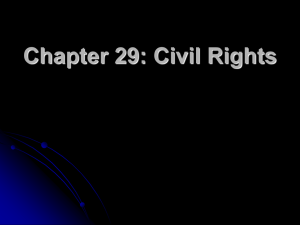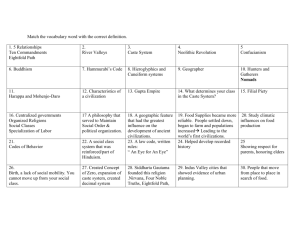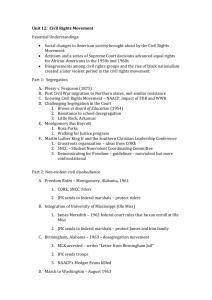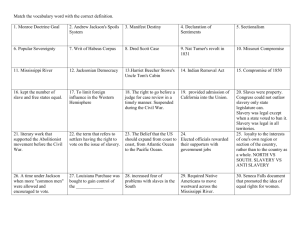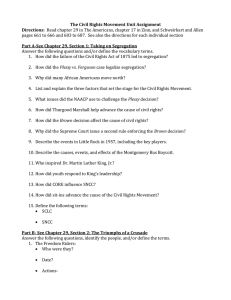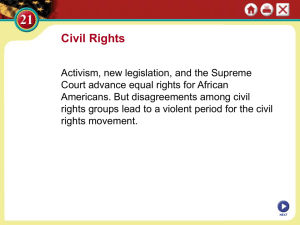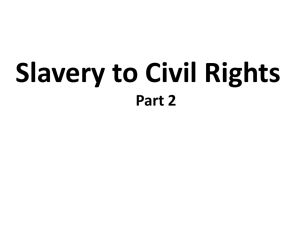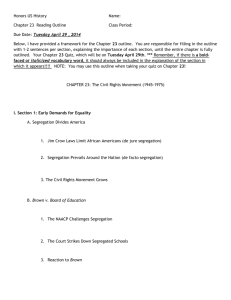Civil Rights Act of 1964
advertisement
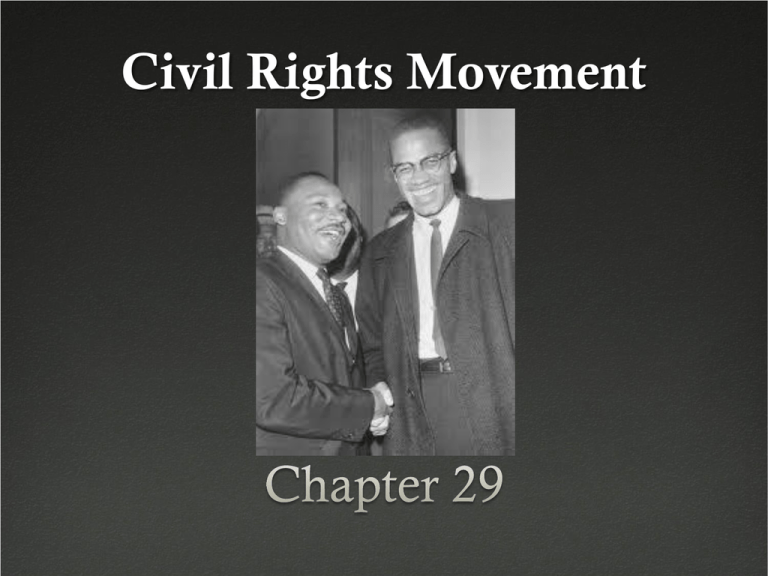
Civil Rights Movement The Segregation System: Plessy v. Ferguson Civil Rights Act of 1875 act outlawed segregation In 1883, all-white Supreme Court declares Act unconstitutional 1896 Plessy v. Ferguson ruling: separate but equal constitutional Many states pass Jim Crow laws separating the races Facilities for blacks always inferior to those for whites Let’s see where we’ve come from! Challenging Segregation in Court: The NAACP Legal Strategy Professor Charles Hamilton Houston leads NAACP legal campaign Focuses on most glaring inequalities of segregated public education Places team of law students under Thurgood Marshall - win 29 out of 32 cases argued before Supreme Court Brown v. Board of Education Marshall’s greatest victory is Brown v. Board of Education of Topeka In 1954 case, Court unanimously strikes down school segregation Reaction to the Brown Decision Resistance to School Desegregation Within 1 year, over 500 school districts desegregate Some districts, state officials, pro-white groups actively resist Court hands Brown II, orders desegregation at “all deliberate speed” Eisenhower refuses to enforce compliance; considers it impossible Crisis in Little Rock Since 1948, Arkansas integrating state university, private groups September 1957: Governor Orval Faubus ordered National Guard to prevent the "Little Rock Nine" nine African American students who volunteered to integrate Little Rock's Central High School- from entering the school. Federal courts got involved. Next day the nine planned to go back but Elizabeth Eckford did not receive a phone call and missed the plan. Made it safely with the help of two white women. President Eisenhower stepped in with military help to protect the students as they attended school. The Montgomery Bus Boycott Boycotting Segregation 1955 NAACP officer Rosa Parks arrested for not giving up seat on bus Montgomery Improvement Association formed, organizes bus boycott Elect 26-year-old Baptist pastor Martin Luther King, Jr. leader Walking for Justice African Americans file lawsuit, boycott buses, use carpools, walk Get support from black community, outside groups, sympathetic whites 1956, Supreme Court outlaws bus segregation Martin Luther King and the SCLC Changing the World with Soul Force King calls his brand of nonviolent resistance “soul force” civil disobedience, massive non-violent demonstrations King remains nonviolent in face of violence after Brown decision The Movement Spreads Demonstrating for Freedom SNCC adopts nonviolence, but calls for more confrontational strategy Influenced by Congress of Racial Equality (CORE) to use sit-ins: - refuse to leave segregated lunch counter until served First sit-in at Greensboro, NC Woolworth’s shown nationwide on TV In spite of abuse, arrests, movement grows, spreads to North Late 1960, lunch counters desegregated in 48 cities in 11 states From the Grassroots Up King, others found Southern Christian Leadership Conference (SCLC) – Nonviolent protest organization By 1960, African-American students think pace of change too slow Join Student Nonviolent Coordinating Committee (SNCC) – national protest group Riding for Freedom CORE’s Freedom Rides 1961, CORE (Congress of Racial Equality) tests Court decision banning interstate bus segregation Freedom riders —blacks, whites sit, use station facilities together Riders brutally beaten by Alabama mobs; one bus firebombed (blockade) New Volunteers Bus companies refuse to continue carrying CORE freedom riders SNCC volunteers replace CORE riders; are violently stopped Robert Kennedy pressures bus company to continue transporting riders Arrival of Federal Marshals Alabama officials don’t give promised protection; mob attacks riders Newspapers throughout nation denounce beatings JFK sends 400 U.S. marshals to protect riders Attorney general, Interstate Commerce Commission act: - ban segregation in all interstate travel facilities Integrating Ole Miss 1962, federal court rules James Meredith may enroll at U of MS Governor Ross Barnett refuses to let Meredith register JFK orders federal marshals to escort Meredith to registrar’s office Barnett makes radio appeal; thousands of white demonstrators riot Federal officials accompany Meredith to classes, protect his parents Heading into Birmingham April 1963, SCLC demonstrate to desegregate Birmingham King arrested, writes “Letter from Birmingham Jail” (later bailed out by Kennedy) TV news show police attacking child marchers—fire hoses, dogs, clubs Continued protests, economic boycott, bad press end segregation Marching to Washington The Dream of Equality August 1963, over 250,000 people converge on Washington Speakers demand immediate passage of civil rights bill King gives “I Have a Dream” speech More Violence September, 4 Birmingham girls killed when bomb thrown into church LBJ signs Civil Rights Act of 1964 prohibits discrimination because of race, religion, gender Fighting for Voting Rights Freedom Summer Freedom Summer — CORE, SNCC project to register blacks to vote in MS Volunteers beaten, killed; businesses, homes, churches burned Voting Rights: The Selma Campaign 1965, voting rights demonstrator killed in Selma, AL King leads 600 protest marchers; TV shows police violently stop them Second march, with federal protection, swells to 25,000 people Voting Rights Act of 1965 Congress finally passes Voting Rights Act of 1965 Stops literacy tests, allows federal officials to enroll voters Increases black voter enrollment African Americans Seek Greater Equality: Northern Segregation De facto segregation exists by practice, custom; problem in North De jure segregation is segregation required by law WW II black migration to Northern cities results in “white flight” 1960s, most urban blacks live in slums; landlords ignore ordinances Black unemployment twice as high as white Many blacks angry at treatment received from white police officers Urban Violence Erupts Mid-1960s, numerous clashes between white authority, black civilians many result in riots (Newark and Jersey City) Many whites baffled by African-American rage Blacks want, need equal opportunity in jobs, housing, education New Leaders Voice Discontent African-American Solidarity Nation of Islam, Black Muslims, advocate blacks separate from whites believed whites to be the source of black problems Malcolm X —controversial Muslim leader, speaker; gets much publicity Frightens whites, moderate blacks; resented by other Black Muslims Ballots or Bullets? Pilgrimage to Mecca changes Malcolm X’s attitude toward whites He realized that Orthodox Islam preached racial equality Splits with Black Muslims; is killed in 1965 while giving speech Black Power CORE, SNCC become more militant; SCLC pursues traditional tactics (MLK doesn’t approve) Stokely Carmichael, head of SNCC, calls for: Black Power: African Americans control own lives, communities, without whites 1968 Olympic Games – Mexico City Black Panthers Black Panthers fight police brutality, want black self-sufficiency MLK says “we shall overcome” BP says “we shall overrun” have violent confrontations with police Provide social services in ghettos, win popular support 1968 - A Turning Point in Civil Rights: King’s Death King objects to Black Power movement, preaching of violence Seems to sense own death in Memphis speech to striking workers Is shot, dies the following day, April 4, 1968 Reactions to King’s Death King’s death leads to worst urban rioting in U.S. history - over 100 cities affected • Kerner Commission names racism as main cause of urban violence Robert Kennedy assassinated two months later Civil Rights Gains Civil Rights Act of 1968 prohibits discrimination in housing More black students finish high school, college; get better jobs Greater pride in racial identity leads to Black Studies programs More African-American participation in movies, television Increased voter registration results in more black elected officials Unfinished Work Forced busing, higher taxes, militancy, riots reduce white support White flight reverses much progress toward school integration Unemployment, poverty higher than for whites Affirmative action —extra effort to hire, enroll discriminated groups (minorities and women) 1960s, colleges, companies doing government business adopt policy Late 1970s, some criticize policy as reverse discrimination
